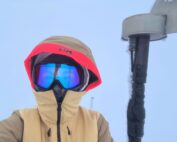Reminiscing about my Summer on the Summit
By Amber Stokes
Hello again! It’s hard to believe my time as an intern is coming to an end. It feels like just yesterday I was sitting in the observatory van, heading up to my first shift on the summit. The past three months have been a whirlwind, starting out as one of three interns on my shift, to solo interning by my last week (my fellow intern, Ryan, is now a night observer!). The amazing observers on my shift, Alex, Charlie, previously Alexis, now Ryan, and museum attendant, Corbin, all made me feel like one of the crew from the start, making my transition to summit life incredibly easy. This internship has helped me grow both as a meteorologist and a person. From learning how to write the higher summits forecasts, to giving numerous tours a week to observatory guests, I’ve discovered a newfound love of both higher-elevation forecasting and public education.
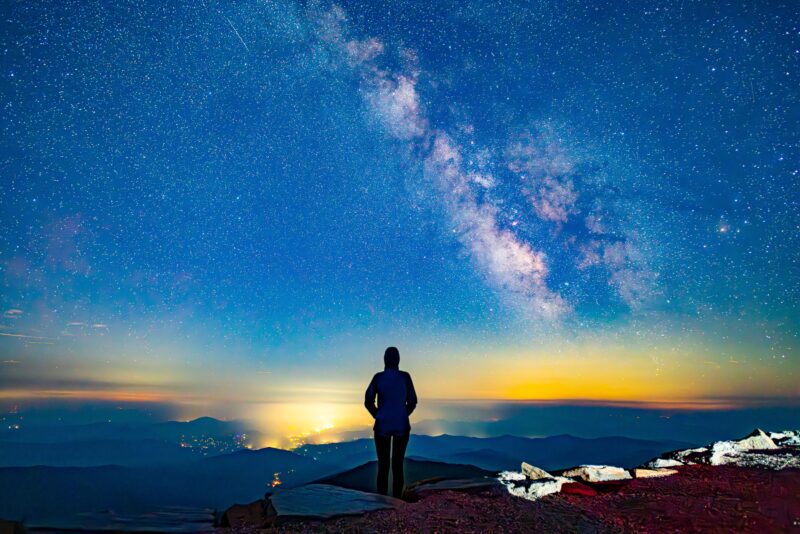
Watching the Milky Way over the glow of North Conway.
When I’m not furiously typing away at my intern desk or wrangling a large observatory tour, I can be found out and about the summit cone, wandering the summit building, or playing with Nimbus to his heart’s content. My first memorable experience was an attempt at hiking down to the Lakes of the Clouds with my fellow interns, just hours after arriving at the summit for the first time. The week before, there had been a large snow and ice event, so the trail still had slippery and wet rocks that made the traverse quite difficult. Unfortunately, we did not make it all the way down before we needed to head back to the summit, but it’s the journey that counts, right? Near the end of my internship, our wonderful volunteers (thank you Bonnie and Fa!) invited me on a hike, and I had the opportunity to both hike up Mount Monroe and run up Mount Franklin for the first time. It was overall one of my favorite adventures of my internship, and I can assuredly say that I plan to have many more just like it.
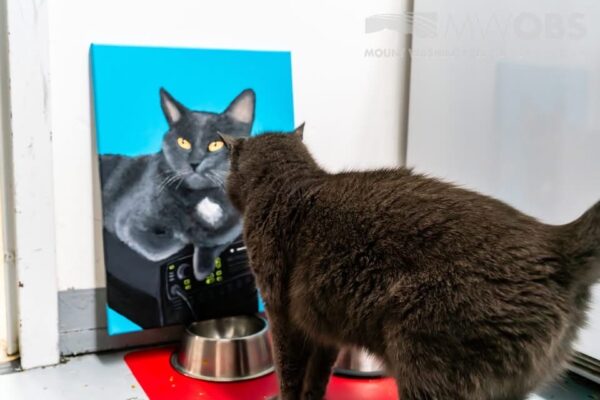
Nimbus admires the portrait I painted for him.
Lots of research has been completed at my desk during this internship as well. Aside from forecasting, I have worked on an independent research project with the observatory. My research project studied the effects of the North Atlantic Oscillation (NAO) on extreme snowfall events on Mount Washington. This global teleconnection has more prominent impacts on the Northeastern United States during the winter months, and is responsible for the changing intensity of mean sea level pressure centers over the Northern Atlantic Ocean.
In my study, the impacts of this large-scale variability on the extreme snowfall events on the summit of Mount Washington, New Hampshire are explored, and any potential correlations are identified. Statistical methods such as a non-parametric Monte Carlo analysis and a parametric generalized extreme value (GEV) distribution are used to help identify these relationships. The results of my study found that while average snowfall between NAO phases does not differ significantly, extreme snowfall behavior changes meaningfully. The distribution of extreme snow events, such as intensity, variability, and likelihood, shifts with the NAO. In the future, the relationship between the NAO and other global teleconnections on extreme snowfall should be studied to uncover all the impacts on changing extreme snowfall events.
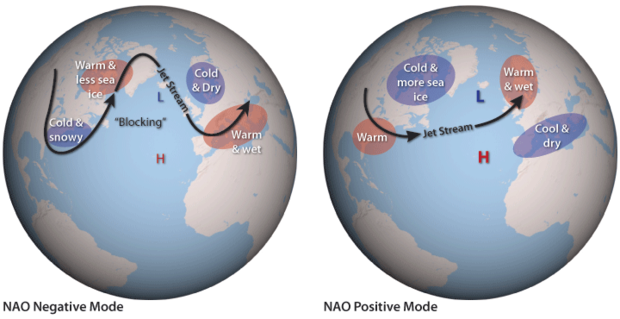
The different phases of the NAO (diagram provided by NOAA’s climate.gov NAO website).
On the last night of my sixth shift, I was outside studying the sky, determined to see the Northern Lights as my time on the mountain was coming to an end. Unfortunately, the combination of haze from Canadian wildfire smoke and an almost full moon proved it a futile effort. But the trip outside was not wasted, because I proceeded to witness (and Corbin can confirm, as the only other original witness) what seemed like a rogue asteroid or UFO slowly spiraling across the night sky. After standing in awe for multiple minutes, and a rush of trying to capture a picture of this strange object, the growing, glowing spiral made its way over the horizon. After a little research, it turns out what we saw was the result of exhaust from a Vulcan Centaur Rocket, which had just launched off Cape Canaveral in Florida, interacting with the atmosphere to create a visible spiral shape in the sky. I went outside that night hoping to see something spectacular and I can confidently say my wish was granted.
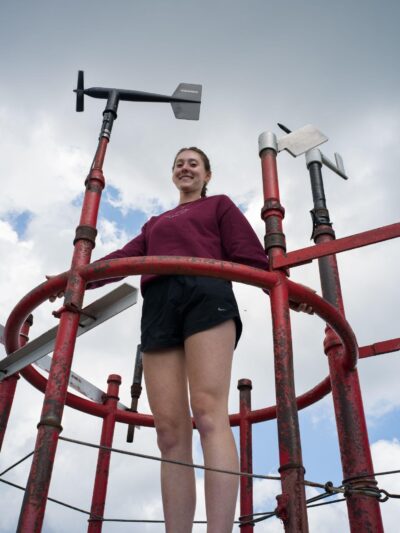
Enjoying unusually low winds on the parapet. (Photo by Calvin Falk)
So, as I sign off for one last time, I cannot express how thankful I am to have had the opportunity to be a MWOBS intern. It’s not often you get to spend an extended amount of time with like-minded people who share the same passion about weather as you do. After my final shift, I will move back to the University of Delaware, where I will finish the last year of my undergraduate meteorology degree. I hope to stay connected to the observatory from now on and continue to spread my passion for weather and climate with everyone I can.
Supporter Spotlight: Ryan Shepard
Supporter Spotlight: Ryan Shepard By Ryan Shepard and Carissa Milliman Ever since I was a kid, living in Western New York and growing up with lake effect snow, I thought harsh weather was incredibly
Supporter Spotlight: Erik Rider
Supporter Spotlight: Erik Rider By Wendy Almeida For Erik Rider, supporting Mount Washington Observatory comes from a lifelong fascination with weather and how it shapes daily life. Growing up along the Massachusetts coast, he
An Autumn Above the Clouds on Mount Washington
An Autumn Above the Clouds on Mount Washington By Cassie Farnsworth I don’t know how many times in life you get to say “it was exactly what I hoped it would be,” but my

